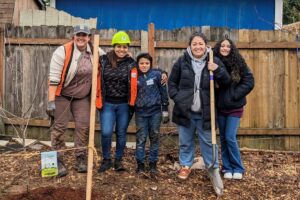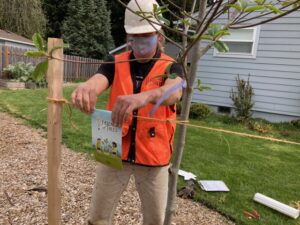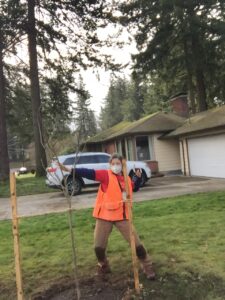Tag: volunteers
Creating Inclusive Planting Events in NE Portland
With Verde, Friends of Trees put on its first Spanish-language led event
While planting trees at a home on Going Street in Northeast Portland, Bella reminded her mother Maria that she wanted to speak Spanish for the entire event. Her mom smiled, and continued her question to Crew Leader Ana in Spanish. Everyone on this particular crew was bilingual, but they embraced the spirit of the event and led with Spanish.
While Friends of Trees has had Spanish-led crews at past events, this planting was the first ever event to be led in Spanish. Friends of Trees partnered with Verde to plan the event and recruit volunteers.
“It was our first ever opening announcements in Spanish, our first Crew Leader huddle in Spanish,” said Neighborhood Trees Senior Specialist Andrew Land, the planting lead for the event and one of the several Friends of Trees staff who speaks Spanish.
The event’s Crew Leaders were all Líderes Verdes, a Verde program supporting the leadership development of Cully’s Latine community. Crew Leaders like Ana organized planters, distributed tools, and demonstrated planting techniques entirely in Spanish.
“We get a lot of people at our events who are bilingual, but I love that we flipped it on its head and led with Spanish,” Andrew said. “It allows us to put Spanish speakers squarely in their comfort zone.”

When a crew showed up to plant at a tree recipient’s home near Fernhill Park, the homeowner happily dusted off her Spanish skills to talk with the crew.
The event was smaller and more intimate than most of our neighborhood plantings, but it still made for a lively and productive morning. Four crews planted 32 trees, and celebrated over a pozole lunch.
“We wanted to keep it small to make sure it went smoothly,” Andrew said. “It went great, and hopefully this is the first of many Spanish events.”

This planting is part of the Clean Air Canopy project. When a NE Portland glass plant reached a settlement with Oregon DEQ related to compliance with their air quality permit, a portion of the penalty contributed funds to approved local environmental projects, including planting trees. Friends of Trees, with partners Verde, Cully Association of Neighbors, and Cully Air Action Team, have focused on making sure these plantings are beneficial and inclusive to the communities they serve.
Training available for key volunteer positions with the Tree Team!
Help us get ready for our 33rd season of planting and caring for trees!
We have training opportunities for key volunteer positions, no experience necessary:

Pruning training sessions – learn to prune!
- Oregon City, 9/25, 9am-12pm: The training is designed for OC residents, but all are welcome
- Wilsonville, 10/2, 9am-12pm: The training is designed for Wilsonville residents, but all are welcome
Remember back in February when the massive ice storm left so much tree destruction in its wake? Did you know that proper structural pruning when a tree is young is a tool you can use to help mitigate major tree failures from wind and ice storms?
Thanks to funding through the City of Oregon City and the Oregon City Community Enhancement Grant, FOT is offering a free, young-tree structural pruning workshop! This workshop will teach you how to identify pruning needs, how and when to prune trees, how to use different tools (no chainsaws!), and more.
How do I register? Visit our online calendar, click on the event, and fill out the quick registration form to reserve your place. Space is limited.
What will the training be like? Participants will learn from and practice alongside FOT staff and experienced FOT pruning volunteers as they prune young trees. Participants will also receive educational materials that provide more information on basic pruning techniques, how structural pruning can be used to improve tree resiliency, and the importance of young tree care and a healthy urban forest.
What about Covid-19? Friends of Trees continues to take safety very seriously and are using the following precautions at this time:
- All volunteers are required to be fully-vaccinated against Covid-19, and willing to show proof at their event if asked. OR are not eligible for the Covid-19 vaccine at the time of their event (e.g. due to being under 12 years old, or severely immunocompromised).
- All volunteers and staff wear a properly fitted mask to the event and through event introductions. After crews split off and are more spread out pruning, those who prefer are welcome to remove their masks as long as they can remain 6’+ apart.
- If you feel unwell within 2 weeks of the event, please cancel your volunteer registration.
- Please bring your own food and snacks, there will likely not be any shared food or drinks provided by FOT, we hope to return to shared coffee and breakfast snacks as soon as it is safer to do so!
- FOT is committed to limiting the risk of exposure for our volunteers and staff in every possible way while continuing to prune, plant, and bring people together safely outdoors. For a full list of our Covid-19 protocol, please see our Volunteer FAQ page.
Crew Leader Training – lead teams of tree planters!

If you are looking for a way to combat climate change and create a more equitable community, you might just be a future Friends of Trees Crew Leader!
If you want to lead the public to plant trees in parks and neighborhoods that don’t have as many, you might be a future Friends of Trees Crew Leader!
If you want to make a lasting, positive change in a fun and physical(ly-distanced) way and you don’t mind working in the mud and rain, then you might be ready to become a Friends of Trees Crew Leader!
And we hope you do — all are welcome!
Visit our Crew Leader training webpage to see your online and in-person training options. Space is limited, register soon to hold your spot at one of these fun Fall trainings!
Volunteer Spotlight

An incredibly challenging planting season has come to a close and we are indebted to many people who went above and beyond to help make sure 21,000 trees + native shrubs were planted. We’ll be highlighting a few of these folks over the coming months, volunteers who really made a difference, despite the obstacles.
Meet Mallory Pratt!
Mallory (she/her) started volunteering back in 2013. Ever since she’s been a powerhouse planting, pruning, summer inspecting where it’s most needed. When it comes to community tree work Mallory does it all! In her own words:
I love trees and Friends of Trees is an amazing organization that puts science and civics and people and fun all together to give our urban landscape more of them! How could I not volunteer?
C19 reminded me that the people part is just as important as the tree part! Not just cause it’s harder to plant a tree by yourself, but because sharing tree love with others and learning together is so much fun:) That and I soooo miss the lunch potluck.
Do you have any memories of the 20-21 planting season that stand out?
Digging through Missoula-flood-soil to make the right size hole for a surprisingly big native oak by myself.
The joy of having an Assistant Crew Leader to work with in February!!
Not loading and unloading trees from trucks:) Thank you Friends of Trees staff who did so much heavy lifting and coordination of that!!!!
Connecting with homeowners desperate to talk to someone they don’t live with:)
What advice do you have for other Crew Leaders? Share what you’ve learned and learn from others. Smile a lot.
Planting manager Ian Bonham shares a few words about Mallory : Mallory’s been planting with FOT longer than I have, but it wasn’t until this season that we finally got to have a bit of one-on-one time. There was this week in January where I kept running into Mallory at the FOT house when she was picking up tools and maps to plant or prune a route of trees. We had a few long conversations in the FOT parking lot, joking about our muddy masks, hunting for public restrooms, and the peculiarities of planting trees in a pandemic. I literally screeched with laughter a few times and she really lifted my spirits during a pretty dark time. Several weeks later I got repeated requests from volunteers who wanted to be on her planting crews—I can totally understand why. Mallory clearly finds real joy in doing good work for and with her neighbors, and she does a great job of sharing it too.
Mallory, thank you for buoying this work the last 8+ years, but particularly during these pandemic daze! You have a big heart, and like Ian (kinda) said, your joy is a contagion that we wanna catch!!
Tis the season … for Give!Guide

The 2020 Give!Guide is here!
Willamette Week’s Give!Guide runs through December 31st and is a great way to learn about organizations that are doing amazing work on behalf of people, places, critters and causes (including trees + community, of course ;).
G!G features Big Give Days when donors are entered to win fabulous incentives like shopping sprees, vacation packages, and more.
Why give? Now more than ever, we need trees! They fight climate change, clean our air and water, and make this place beautiful. And when planted the Friends of Trees way, with all kinds of volunteers, trees grow community (ands we need that more than ever, too!).
Tree care – we do that too!

Congratulations, you helped plant 50,000 trees and native shrubs last season! Now what? Good thing Friends of Trees isn’t just a tree planting organization–tree care is also on the list because we want the trees we plant to survive and grow and thrive.
It works.The survival rate for urban trees planted the Friends of Trees way, together, with guided post-planting care from our Tree Team, is 97% (based on Portland street trees planted last season). For the subset of trees we’ve been monitoring for nine years since planting it’s an 88% survival rate.
Our trees planted in natural areas also have strong survival rates, especially given some very challenging conditions; for example, some planting sites are not accessible for watering; some plants get eaten by wildlife; humans sometimes trample or vandalize; etc. Some studies indicate that an acceptable minimum survival rate for riparian area restoration plantings is 50%, so our survival rates of 81% in year one and 70% after three years are particularly impressive.
How do we help trees thrive?
We water. We prune. We mulch. We visit and assess. We do this for the street and yard trees planted through our Neighborhood Trees program as well as for the native trees and shrubs planted in our Green Space program.
As part of our Neighborhood Trees post-planting care, we:
- continually share information with tree-recipients about how much water, mulch and pruning trees need;
- deliver and apply free mulch soon after trees are planted;
- offer a summer watering service for a reasonable fee;
- have a Summer Inspector program where trained volunteers visit all newly planted trees twice in the first summer after planting to inspect for tree health, leaving tree care info for the tree recipient.
- have a longer term monitoring program where we visit subsets of trees planted anywhere from two to 10 years ago, to track health and growth;
- prune trees throughout the year (except for a few weeks in the spring and fall when trees are budding or dropping leaves). We rotate neighborhoods each year and focus most of our work on low income, low canopy and/or historically under-served communities.
Did we mention we prune? Last season we pruned more than 1,600 street trees, which is vital toward proper growth and really helps them survive wind, snow, and ice storms.
Our Green Space program also cares for the new trees and shrubs planted in natural areas, and we do this for up to 10 years after planting. The team is often joined by employee volunteer groups who help with summer maintenance tasks such as watering, mulching, and weeding (also called “day-lighting” since we’re clearing space around new plantings to provide for more light and air, and to reduce competition with weeds). We also assess for survival and replant when necessary.
Volunteers help with this! We train volunteers to inspect and prune trees, and volunteers are crucial to effectively mulching thousands of new trees at tree care events.
All told, we care for and monitor more than 54,000 trees a year!
We’re spreading the good word about trees.
We spend much of the summer spreading the word. Our Volunteer & Outreach Team, aided by dedicated Tree Team Ambassadors, attend events, festivals and fairs; plus, we have a crew of Canvassers who go door to door in priority neighborhoods. We strive to reach historically under-served, low-canopy neighborhoods with information about how to volunteer with us and how to get a tree from us. Interested in being a part of this? We’d love for you to join us.

